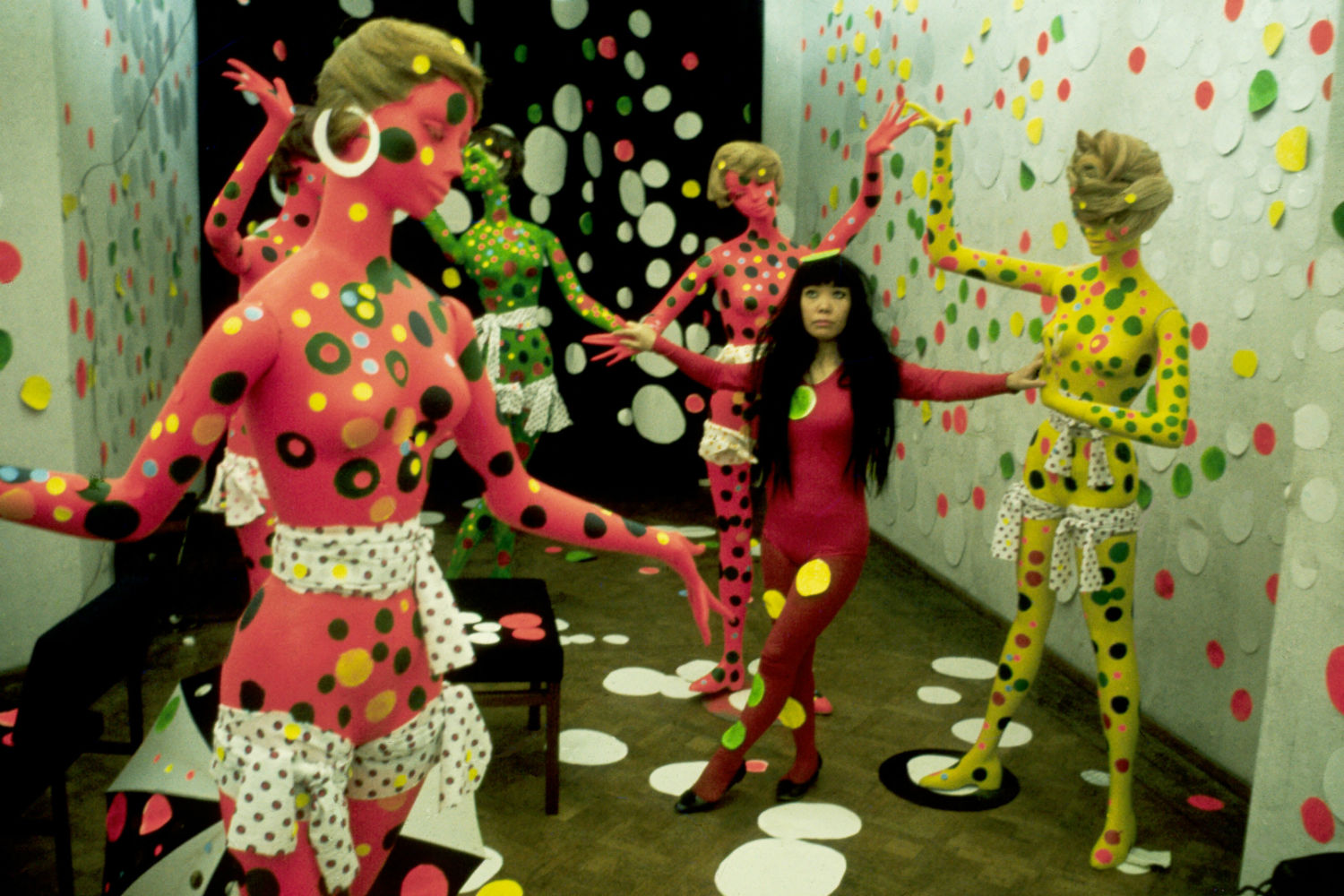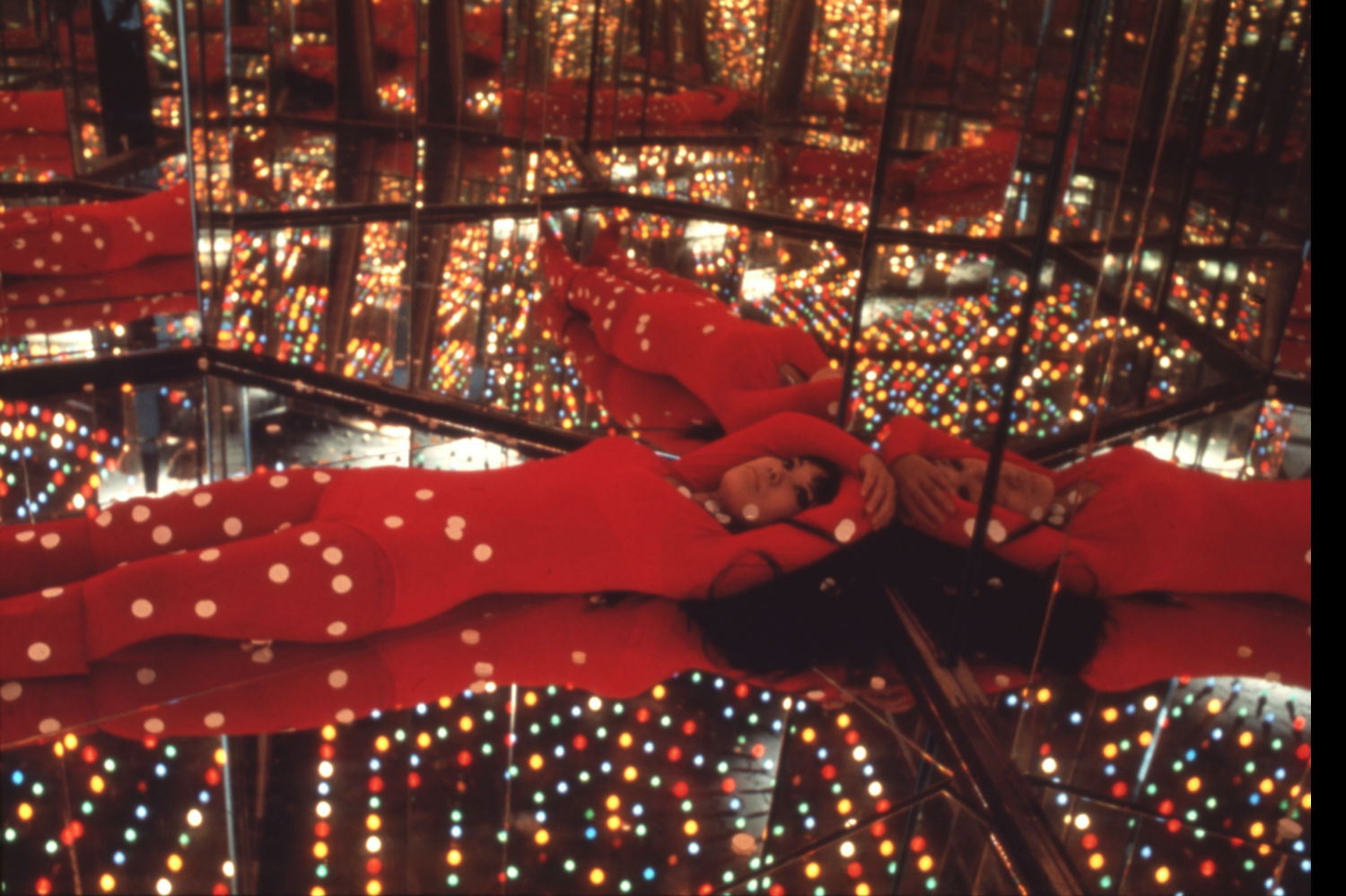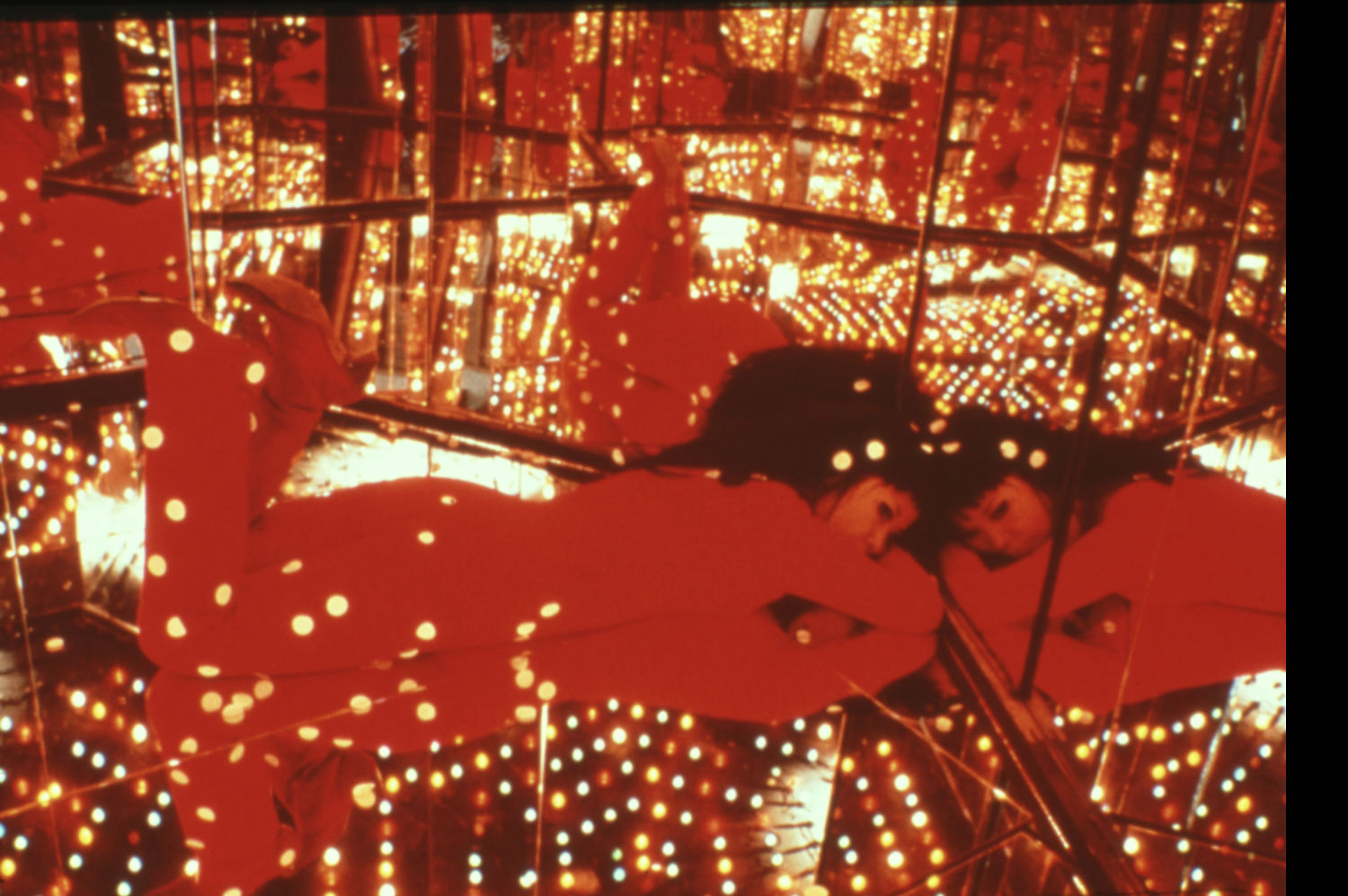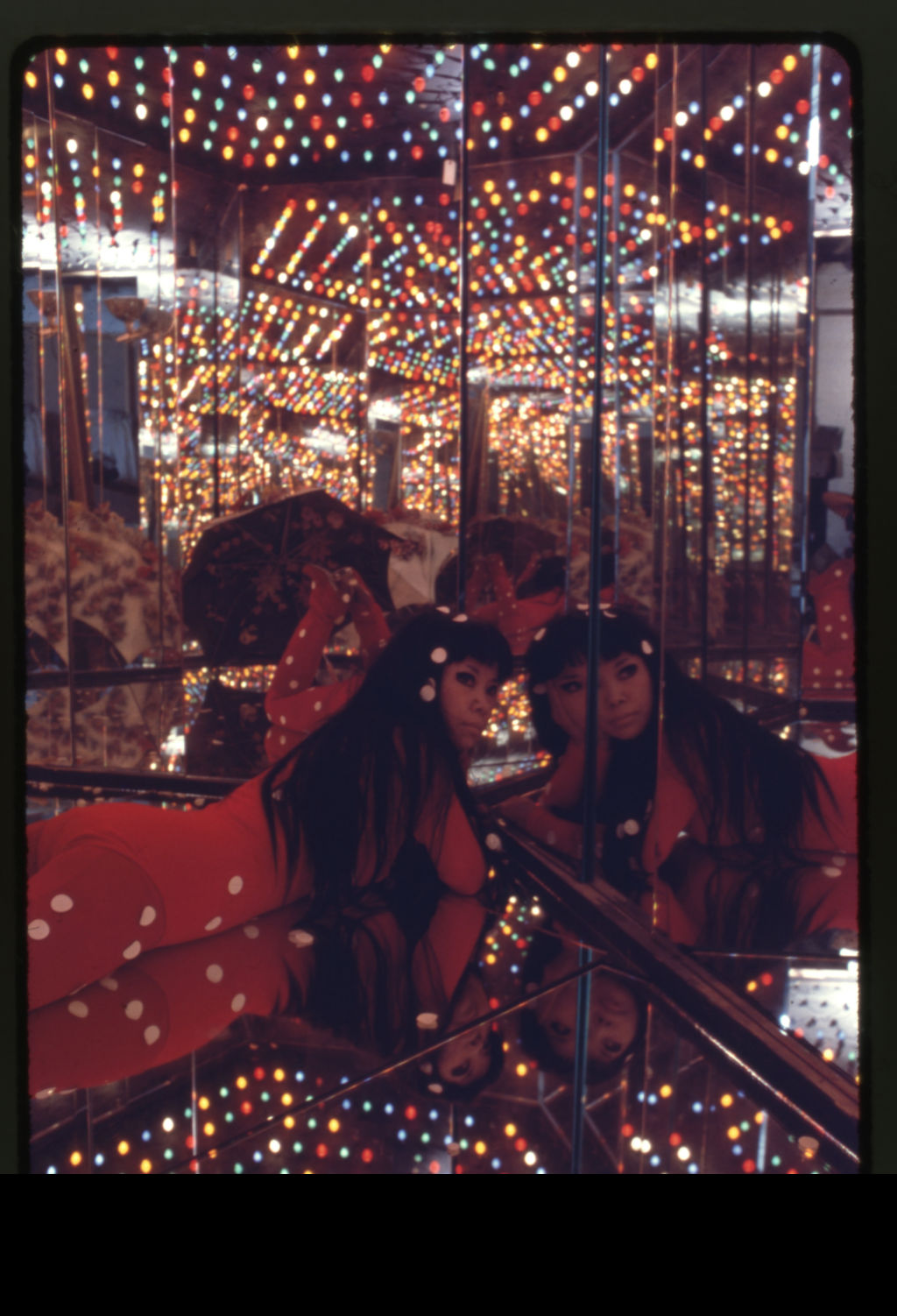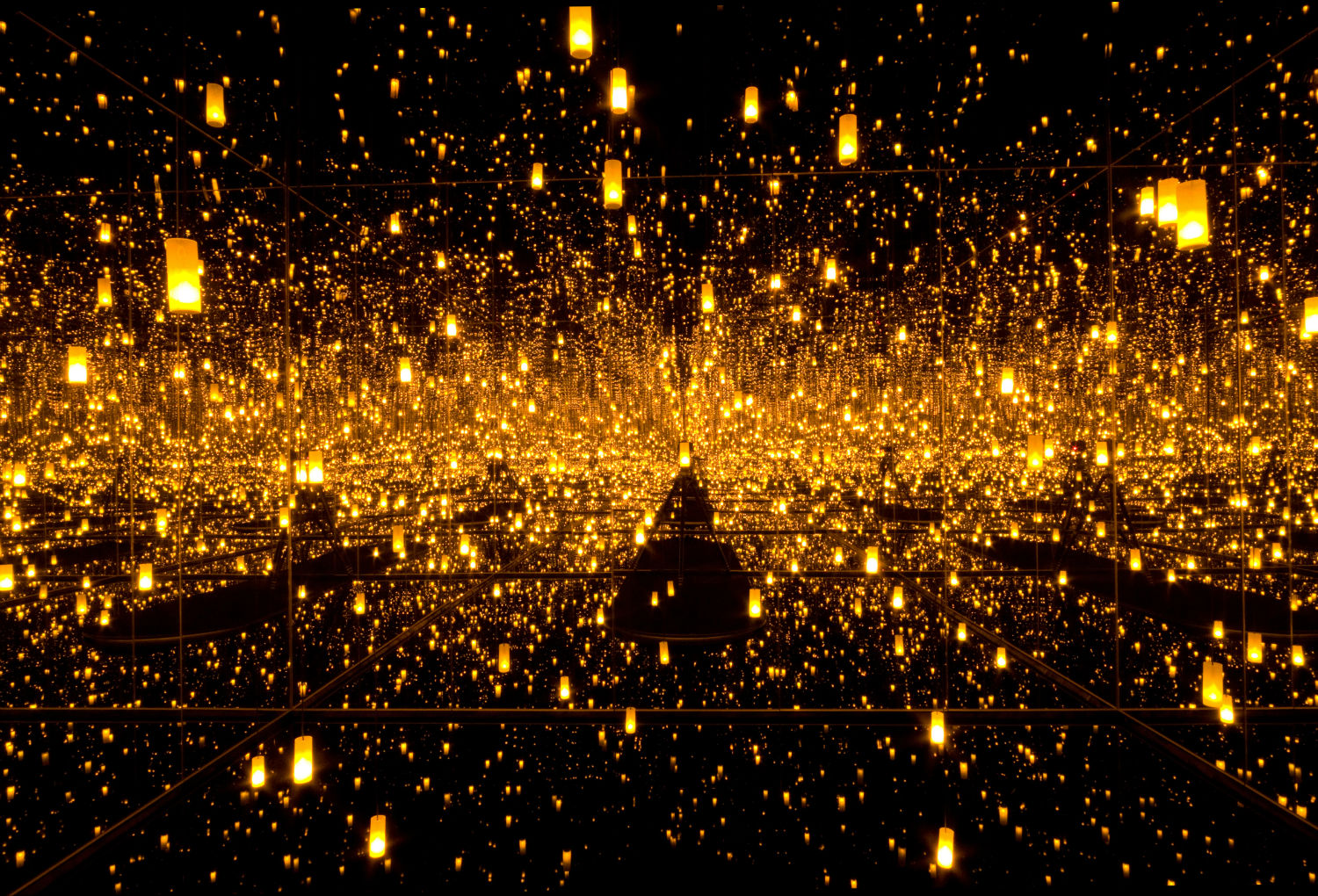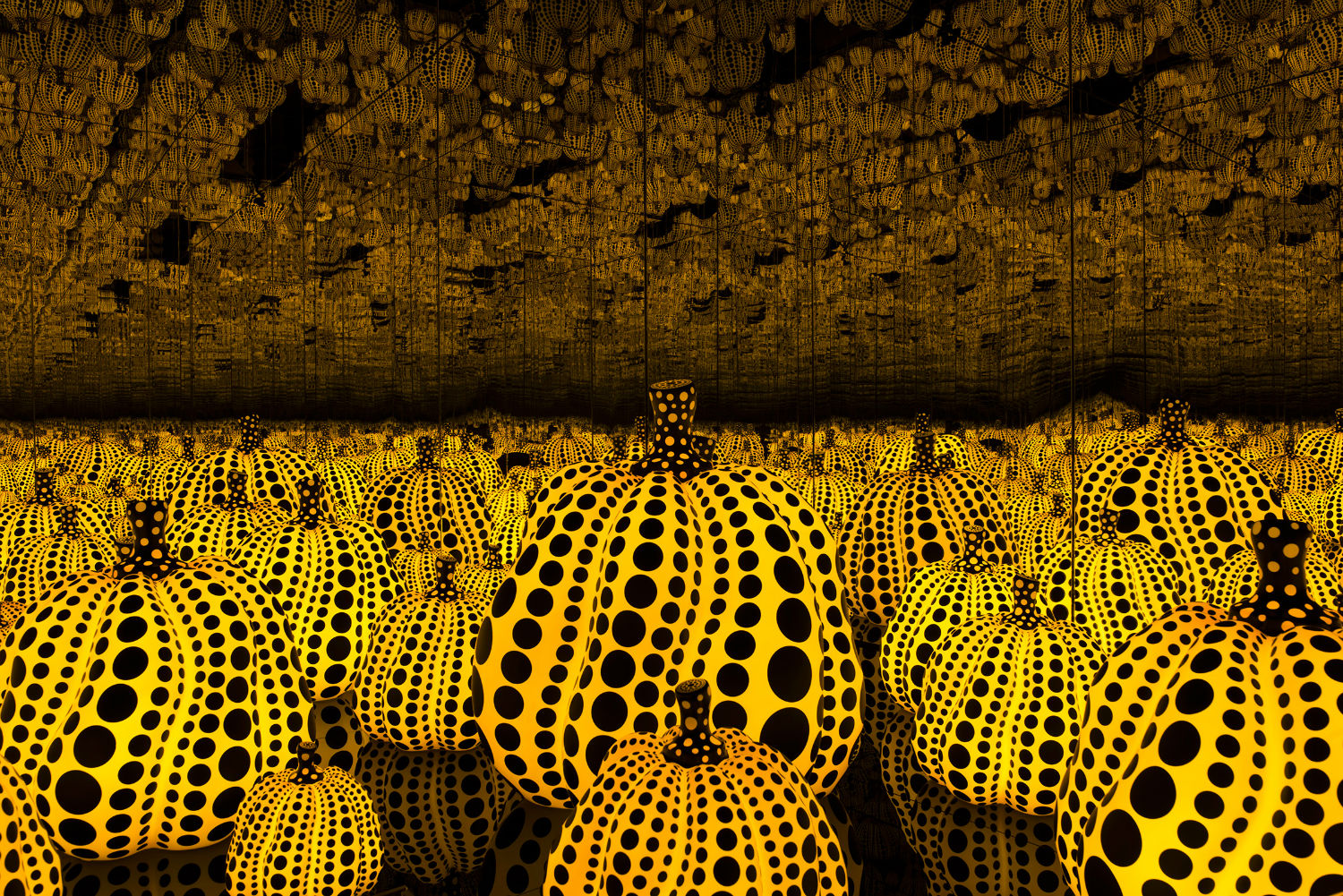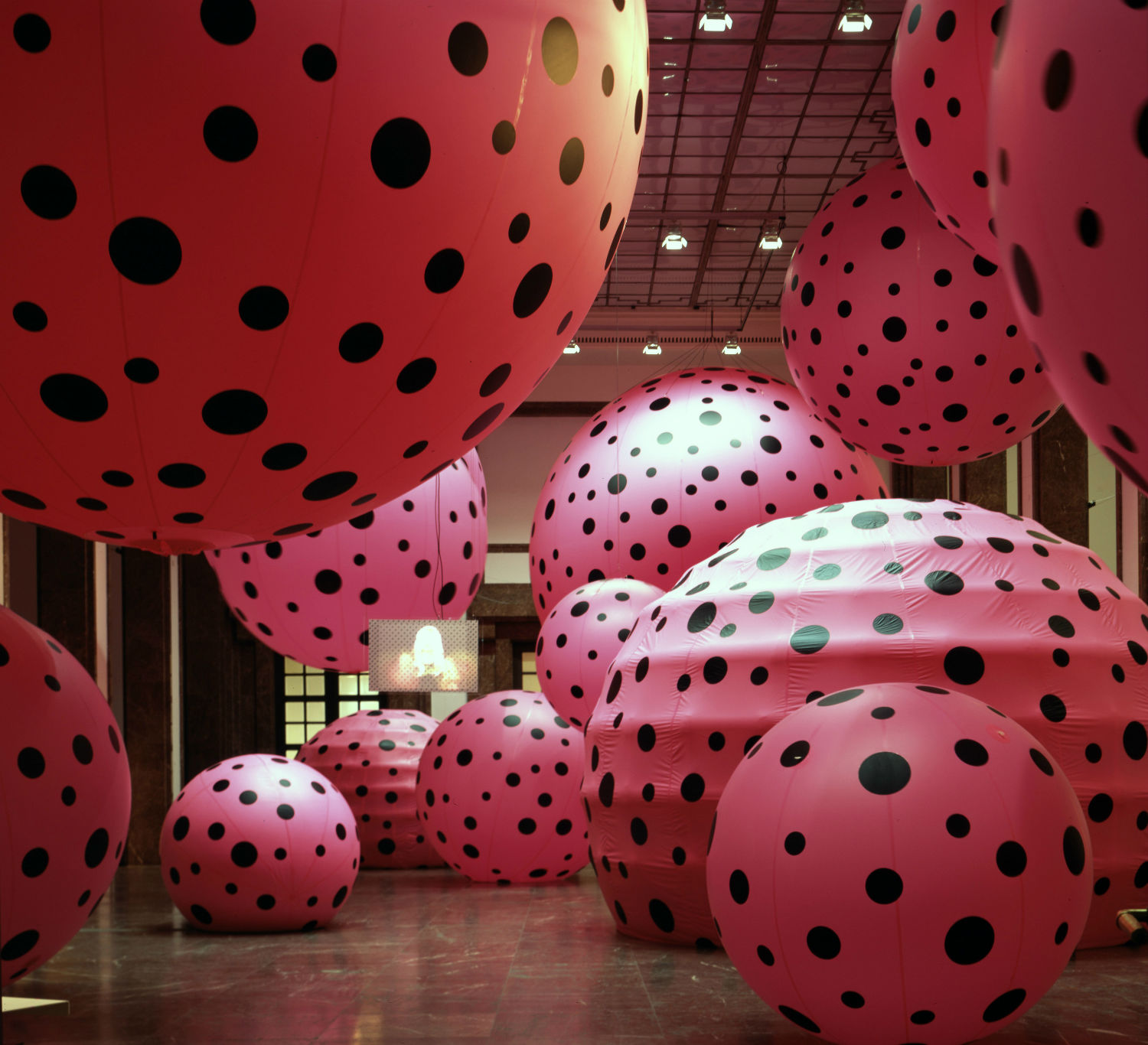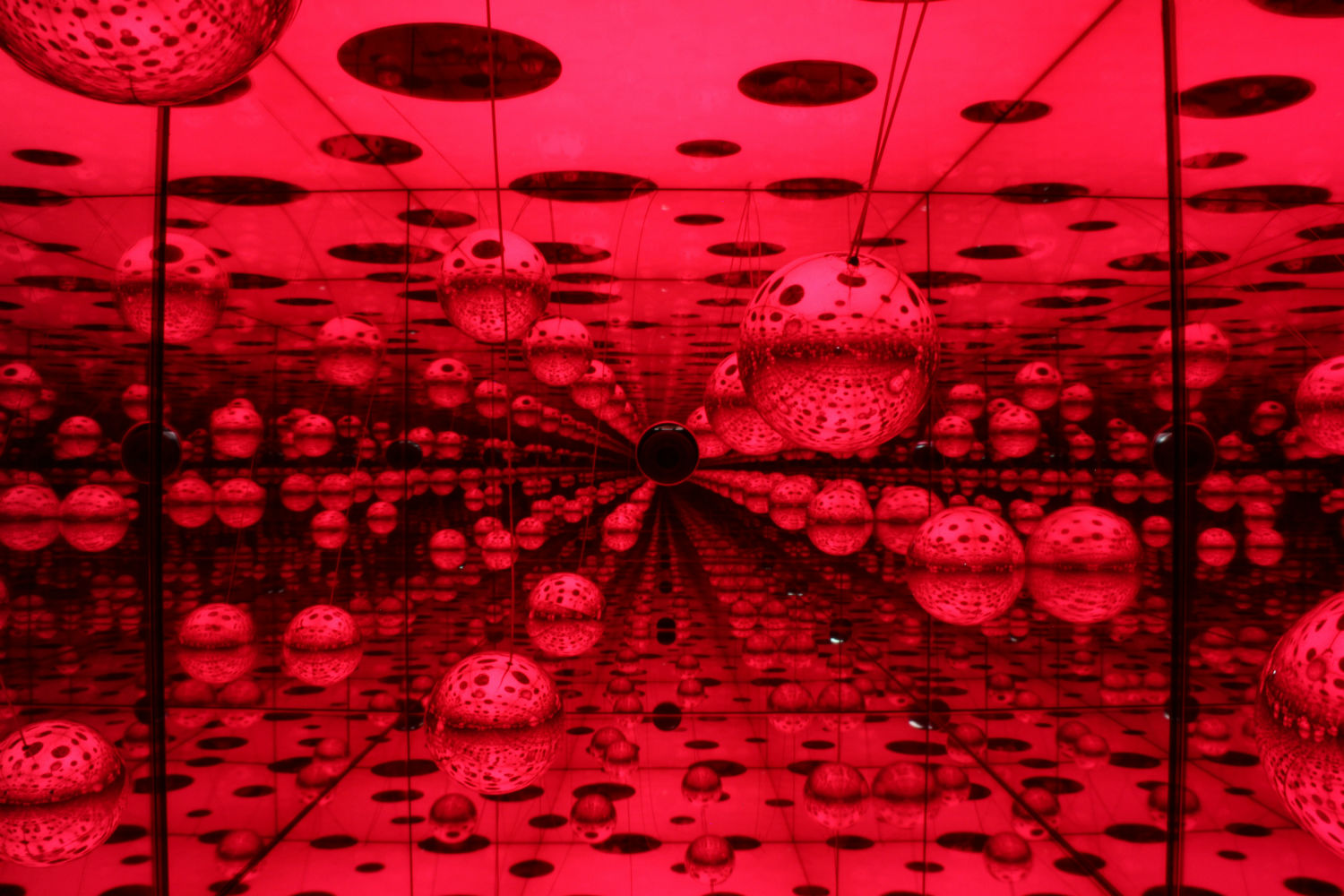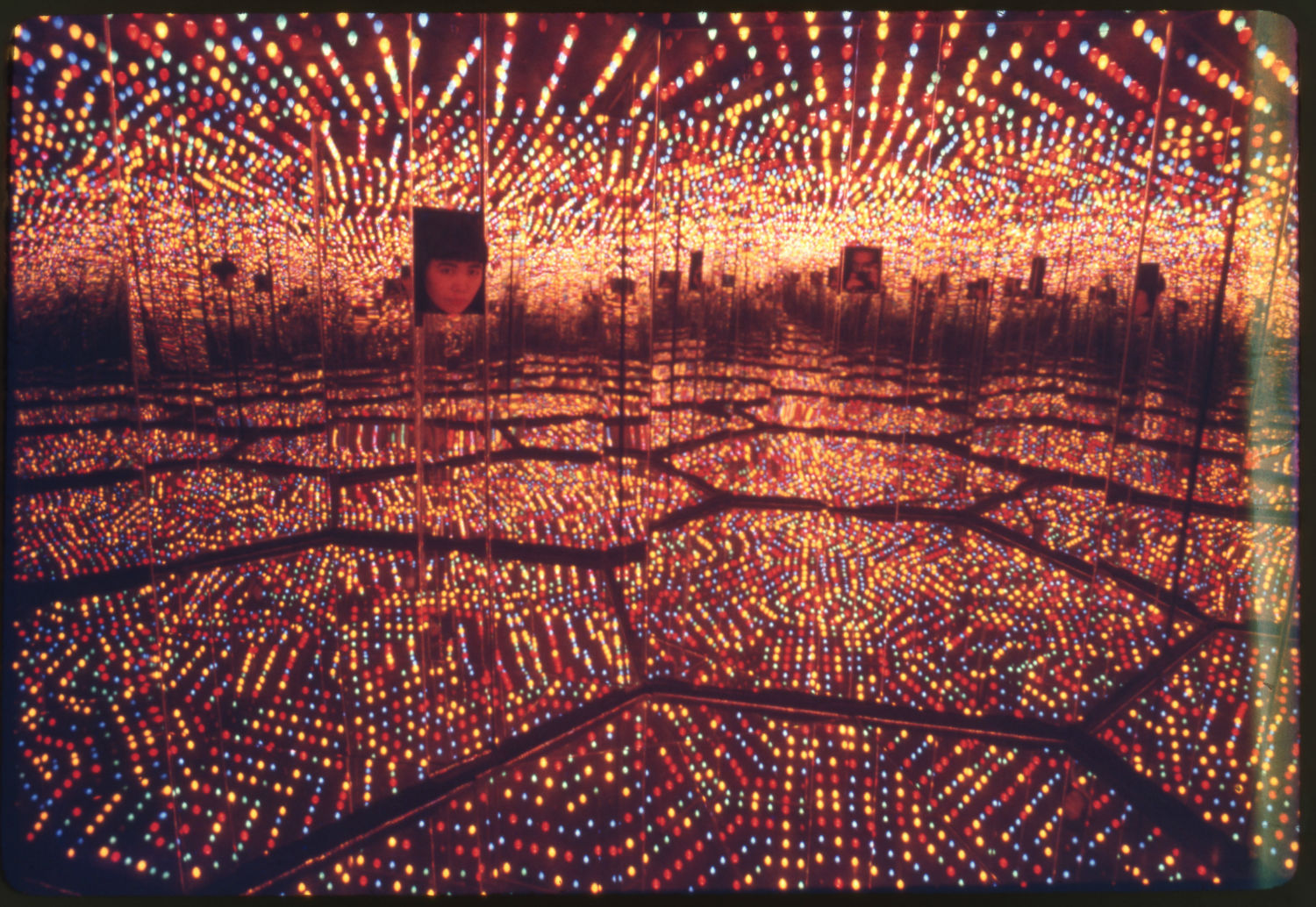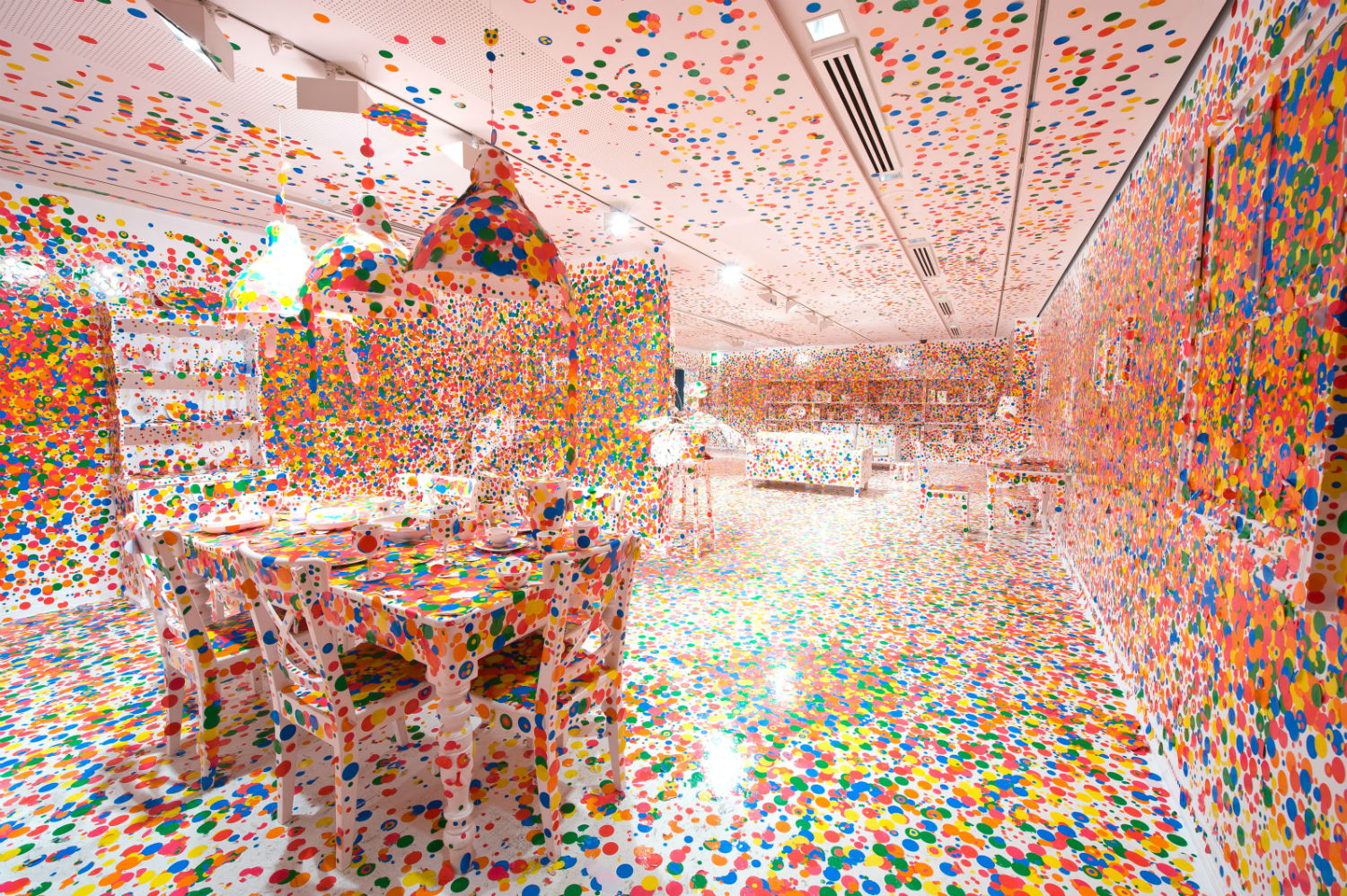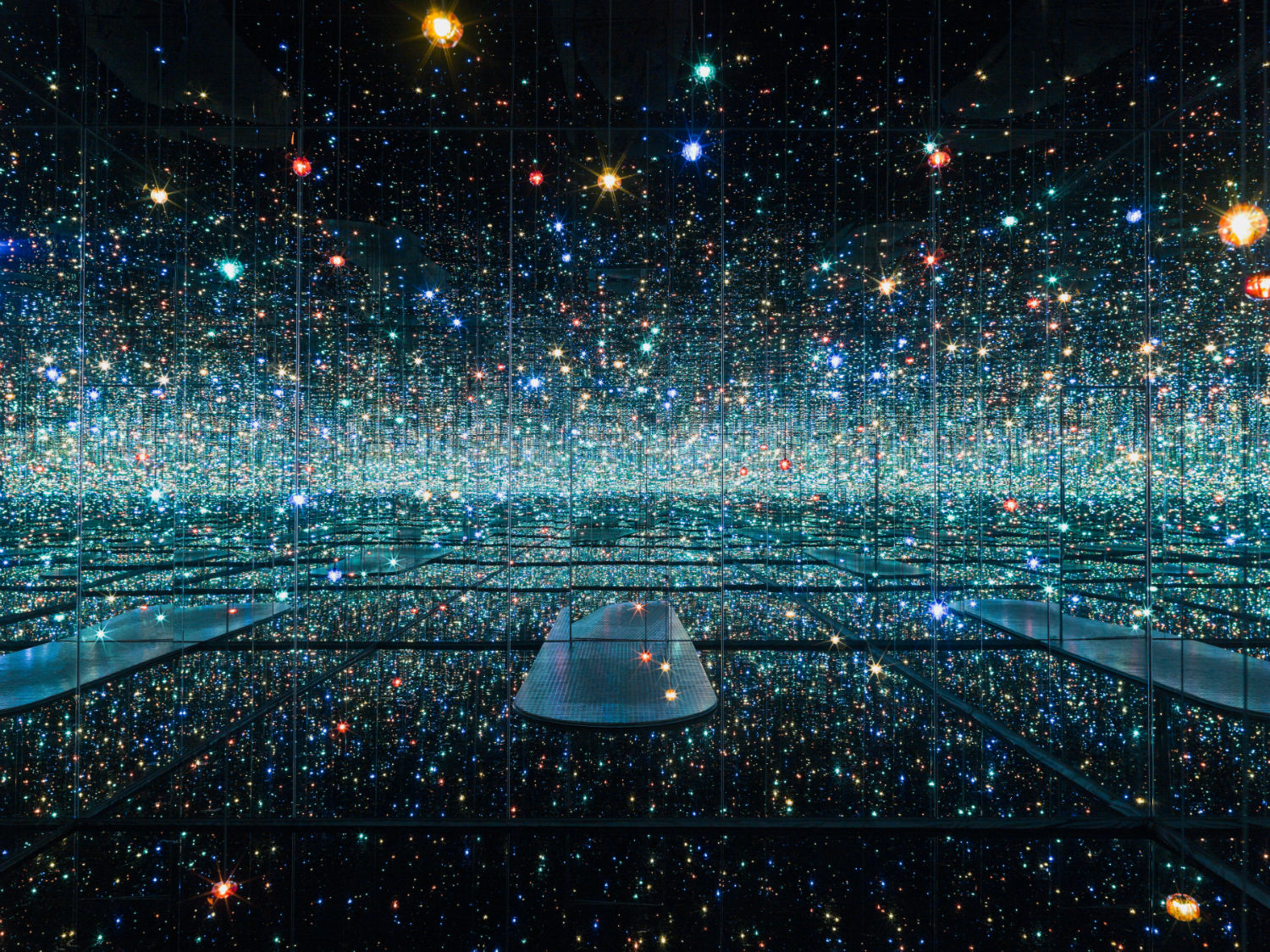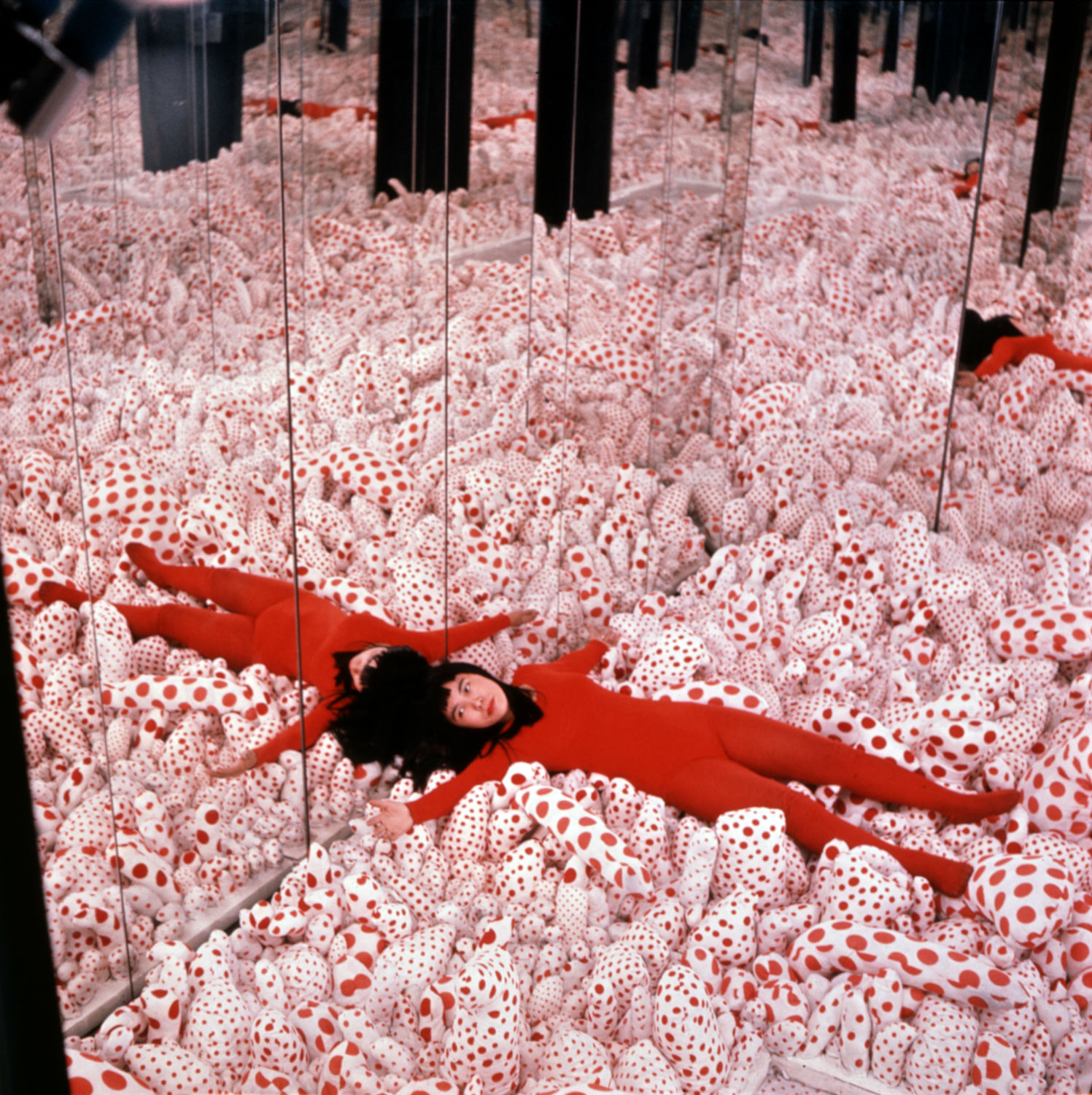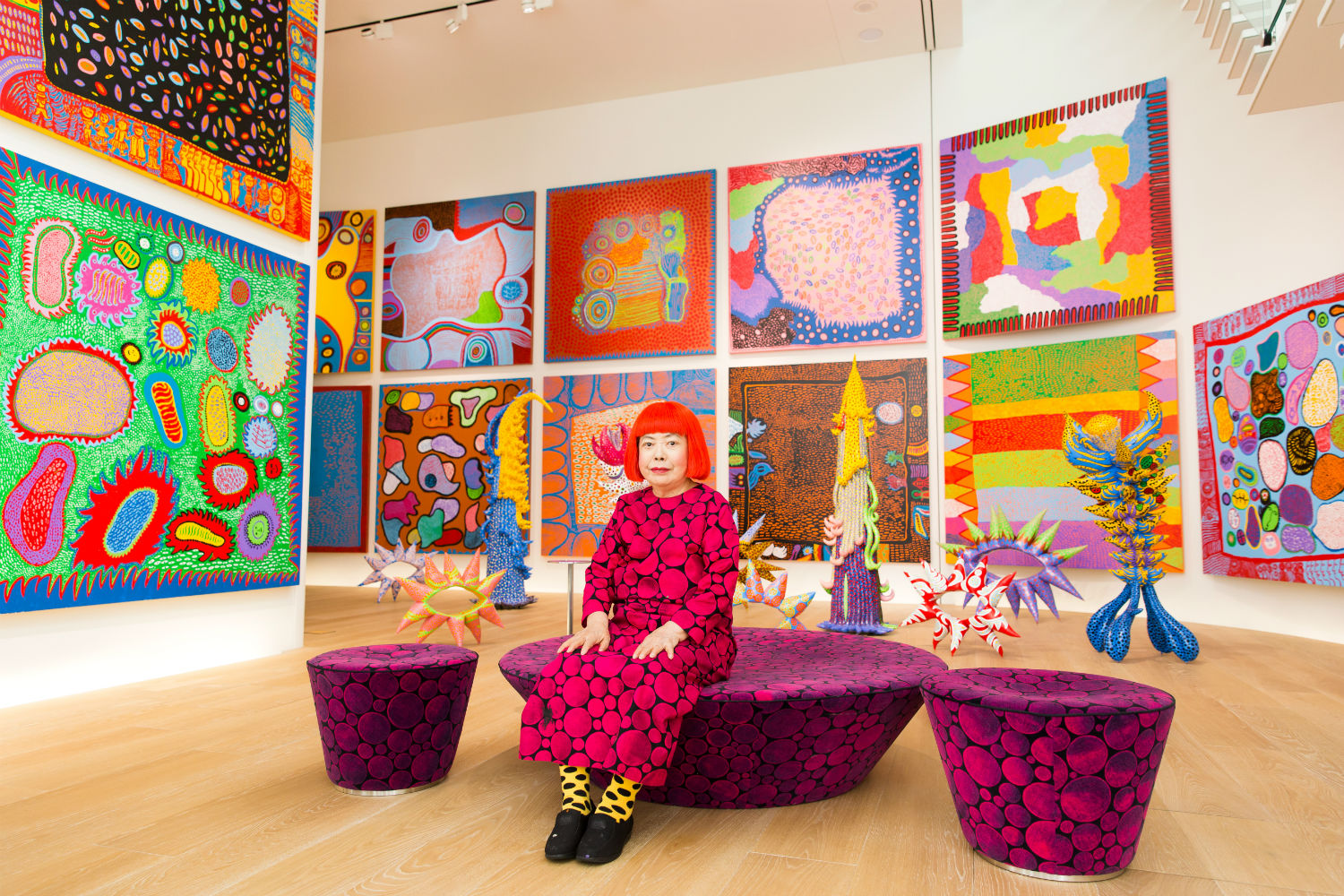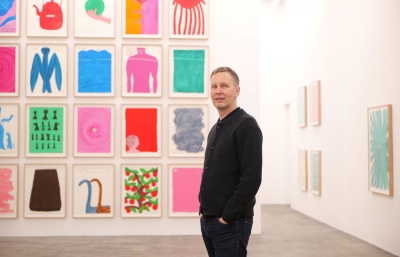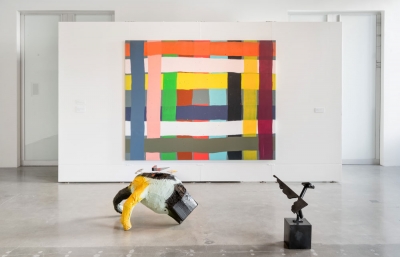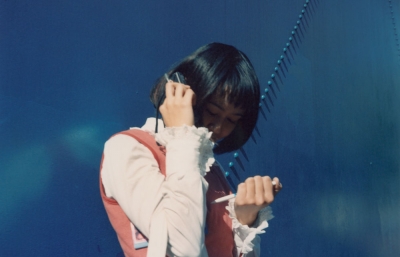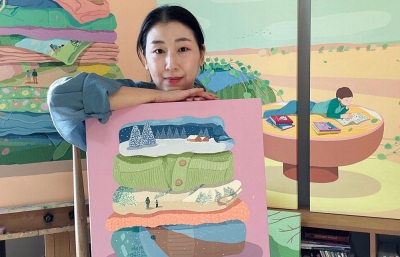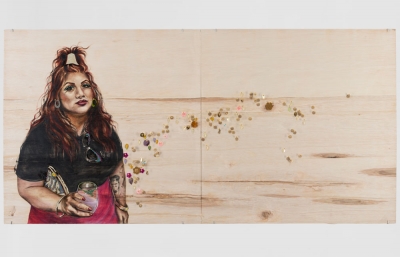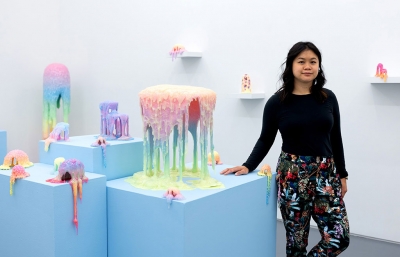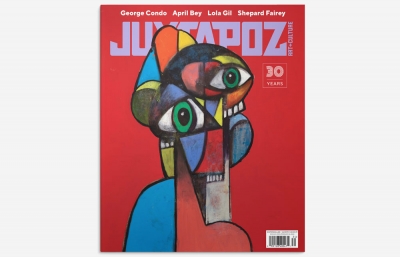When visiting David Zwirner’s opening reception for Yayoi Kusama, I Who Have Arrived In Heaven (2013), I was given a rare opportunity. Gallery assistants ushered out the crowds, but there was no line to see the artist's Infinity Mirror Room installations. I walked through the threshold into a kaleidoscopic universe of floating lights.
In the following weeks, buzz grew about the mirror rooms and so did the lines. That mirror room I had stumbled into emerged again as the crowd pleaser at the opening of The Broad (LA), its new permanent home. Infinity Mirrored Room—Souls of Millions of Light Years Away has become so popular now, the museum website has a disclaimer that not all visitors who want to see it will be able to.
Yayoi Kusama is truly one of the most celebrated artists to emerge from postwar Japan. I should have known that she would team up with Mika Yoshitake, who has produced blockbuster exhibitions like 2007’s ©Murakami at MOCA and her revival of Mono-ha at Blum & Poe in 2012. Mika, who is an expert on Japanese contemporary art, was raised amongst the Japanese avant-garde in Los Angeles and later finished her PhD at UCLA. Mika and I first met as 16-year-olds and later, we both studied at UC Berkeley—Mika in the art history department and I in art practice.
The cultural landscape of Berkeley had been molded by decades of being the epicenter of the hippie movement. It is no wonder that my experiences during these years have deepened my understanding and resonance with Kusama’s mirror rooms. These installations originated during the spiritual exploration of the 1960s, evolving from other art forms rooted in social activism and participation.

Kusama’s Peep Show or Endless Love Show, 1966. Hexagonal mirrored room and electric lights. Installed at Castellane Gallery, New York, 1966. No longer extant. © Yayoi Kusama
In 2000, Kusama unveiled Fireflies on the Water, her first of a new kind of Infinity Mirror Room. It was dark, with many small lights that began to appear like distant galaxies when reflected back and forth in the space. Hearing her speak about these mirror rooms in a video interview with the Hirshhorn confirmed my intuition about her intent to bring greater peace to the world.
In her catalog essay, Mika recognizes that while in these mirror rooms, Kusama makes us aware of our bodies' dual experience of intimate compression and epic expansion in space. As the repetition of beautiful lights draw us into the glimmer of expanding space, we face the challenge of watching our visual concept of the self dissolve with each smaller reflection. These Infinity Mirror Rooms are meditation chambers where Kusama has found a creative means to achieve personal and social harmony, while offering the world a view of itself within the infinite.
On my way south for the holidays, I stopped into the Hirshhorn to visit Mika for tea and cookies, and we talked about what promises to be one of the coming year’s most epic exhibitions. Yayoi Kusama: Infinity Mirrors is the artist’s first North American Tour in 20 years.
Read this feature and more in the March 2017 issue of Juxtapoz Magazine.
David Molesky: I've heard that Kusama’s continuous production of work prevents her from spiraling into difficult mind states. At what point did her mental condition become identified?
Mika Yoshitake: Kusama was born in the late 1920s and grew up in a well-to-do family who owned a seed nursery in the mountainous region of Matsumoto in Nagano Prefecture, Japan. She was the youngest of four and her mother was very strict. Intense childhood experiences contributed to a prolonged fear and anxiety about sex, and she started having hallucinations of flowers and dots she drew. Starting all over her hand and arm, they began to bleed out onto the floor and walls. She wasn't on drugs, but these visions of proliferation and repetition of imagery were very physical. At 19, she enrolled in Nihonga (Japanese-style painting courses) in Kyoto, challenging its traditions, which led her to experiment with abstraction. She returned to Matsumoto where she had her first solo show in 1952. There she met a psychiatrist who determined that she suffered from cenesthopathy, a syndrome where one experiences strange bodily sensations that are unexplained. He presented a paper on her work, "Genius Woman Artist with Schizophrenic Tendency," in 1953, describing periods of intense creativity and unproductivity. This paper caught the attention of an important art critic and led to opportunities for Kusama to exhibit in Tokyo. These early hallucinations are the source of her polka dot motif, and the repetitive gesture is like an endless void she tries to fill as well as an ongoing therapeutic process.
The current show at the Hirshhorn, however, does not intend to pathologize her, though past exhibition catalogs mention her mental condition with intrigue, sometimes even reinforcing the myth of the insane artist. This exhibition is about viewing her practice through the lens of the Infinity Mirror Rooms. It reconsiders the idea of infinity created through analog space in a contemporary age where virtual reality and virtual spaces are becoming a part of our daily experience more than ever before. I think that is why these rooms have such a popular resonance in social media and digital technology.

Installation view of Infinity Mirror Room—Phalli's Field, 1965, in Floor Show, Castellane Gallery, New York, 1965. Sewn stuffed cotton fabric, board, and mirrors. Courtesy of Ota Fine Arts, Tokyo/Singapore; Victoria Miro, London; David Zwirner, New York. © Yayoi Kusama
Kusama seems to heal herself through work that perceptually connects her to the greater cosmos, similar to the psychedelic experiences illustrated by Alex Grey.
During the 1960‘s anti-Vietnam war era, she promoted a sense of radical connectivity through a philosophy she called self-obliteration. She organized performances and happenings where people would paint polka dots on each other’s naked bodies to equalize and encourage the loss of one’s ego. It was an indirect commentary against the US invasion into Vietnam. She also made a hexagonal chamber with mirrors lined inside and out called Kusama's Peep Show/Endless Love Show in 1966. Through two sets of peepholes, lovers could observe each other within the reflective space. These rooms were meant to be disorienting, with thousands of versions of yourself fragmented and repeated into an illusion of infinite space. There is certainly this idea of losing oneself in the infinite expanse of the universe.
These Infinity Mirror Rooms remind me of visualizations I’ve had while reading sacred Buddhist texts.
I can see a resonance to the fantastical imagery of enlightenment in Pure Land Buddhism. In the late ’60s, Sidney Tillim, a famous NY-based art critic, distinguished her work from Abstract Expressionism through Zen Buddhist terms, describing it as a form of meditative detachment. I think she retaliated against people possibly pigeonholing her work, as it really doesn't have anything to do with Zen. This was a time when orientalist attitudes were commonplace. But now, I think she has learned to embrace her customs and culture in her work. One Infinity Mirror Room called The Obliteration of the Aftermath of Eternity, contains traditional Japanese-type lanterns that flicker. It feels a bit more somber than the other rooms. In the catalogue, I compare it to an annual summer festival called tōrō-nagashi in Hiroshima where thousands of lanterns float on the river to commemorate the victims of the atomic bomb. Kusama would probably shy away from making an overt connection, but there is a cultural resonance with that imagery. In addition to losing oneself in the infinite cosmological expanse of the universe, I think Kusama’s work is about celebrating life, its aftermath, and what happens to us spiritually.
That makes me think of Nicolas Poussin’s painting, Landscape with a Man Being Killed by a Snake. There is the tragedy of the man, and as it expands, you have the witness reacting, the person who sees the reaction of the witness, then the onlookers who are unaware, then into an expanding landscape that is indifferent to the human-scale tragedy. There is a comfort to be gained from understanding this vastness.
Mortality is a major theme throughout her work, especially now as she is aging. Most people think of her work as happy, pop and psychedelic, but I feel like these qualities help us cope with the darker aspects of our eventual death.
Bob Dylan once said, "If it means something to me, then it means something to somebody." There are subjective and learned layers to experience but also ones that are innate and universal, because all humans share the same basic hardware genetically and biologically. We have come to perceive our slight variations as huge differences, but in reality, we are so similar. Kusama understands that these mirror rooms affect her and others on a shared, universal level.
I think it's important to get to that very deep level of shared unity in her work, which can be a profoundly comforting experience. Most people identify Kusama when they see a polka dot or a pumpkin, and there is something about these universal motifs that clearly resonate with a lot of people. It's important to not only see the surfaces in her work, but to understand their effects.

All the Eternal Love I Have for the Pumpkins, 2016. Wood, mirror, plastic, black glass, LED. Collection of the artist. Courtesy of Ota Fine Arts, Tokyo / Singapore and Victoria Miro, London. © Yayoi Kusama
Image repetition serves as bread crumbs leading us out from ourselves. Skipping along into deeper space, it's a visual tactic to heighten our perception of infinity.
The history of Kusama’s work contains an evolution of technical efficiency. After she arrived in New York in 1958, she would go on 50–60 hour stretches, painting without sleeping. She also sewed thousands of stuffed phallic appendages around chairs, couches and other domestic furniture, creating total environments caved in by these phallic sculptures, which she called Accumulations. Her installation piece called Aggregation: One Thousand Boats Show (1963) featured a large rowboat covered with these stuffed, white tubers, which she then photographed and reproduced 999 times. She displayed these photographs with the original row boat, and that photographic image became an icon for this wallpapered environment of 1000 boats. So she begins with the physical labor of repetition, transitions into photographic reproduction, and then to instantaneous reflection using mirrors. Her process of creating repetition follows a logical progression of increased efficiency.
This repetitive labor must aid in dissolving the ego, one of the hallmarks of the psychedelic experience.
While I didn’t intend to make a solely psychedelic connection, my essay shares its title with Aldous Huxley's Doors of Perception (1954), which itself is taken from a line in a William Blake poem that speaks to the idea, "If the doors of perception were cleansed, everything would appear to man as it is, infinite." During the time she began making her first Infinity Mirror Rooms, many people were heavily influenced by that book and the experiences it promoted.
What about the Infinity Mirror Room at The Broad in Los Angeles?
The Broad has one called Souls of Millions of Light Years Away. This work is perhaps the most spectacular, with jeweled colored beads that flicker on a timed sequence. Adele, who first saw an image of the installation via Katy Perry's Instagram, filmed inside this mirror room and used the footage as the backdrop for her live performance of "When We Were Young" at the 2016 BRIT Awards. This is certainly work that has benefited from the power of Instagram. We will exhibit the artist's proof on loan from Kusama’s studio, while The Broad will still have theirs on view. The show is traveling to The Broad this October.

Yayoi Kusama with recent works in Tokyo, 2016. Photo by Tomoaki Makino. Courtesy of the artist © Yayoi Kusama
As a leading expert in Japanese contemporary art, tell us how it came about that the Infinity Mirror Room exhibition would be launched in Washington, DC.
Kusama actually exhibited her Infinity Net paintings in Washington, DC in 1960. Our director, Melissa Chiu, suggested an exhibition that focused on the artist's Infinity Mirror Rooms, so she approached me to see if I'd be interested. Given my expertise in postwar Japanese art and the pioneering role Kusama has played as a transnational artist in both the US and Japan, I was thrilled to curate the show. It is a great opportunity to reconsider her work through the lens of her mirror rooms, and not as a retrospective of which there have been so many. The most recent just traveled through Scandinavia, which followed Latin American and Asian tours in 2014. There was also the great retrospective organized by the Tate in 2012, which traveled to the Pompidou and Whitney, and the MoMA/LACMA survey of her New York years in 1998. Her popularity really exploded after David Zwirner had two mirror rooms in 2013. The Broad acquired theirs from that show, and recently the MFA Houston exhibited Love is Calling, the other mirror room featured at Zwirner, and also acquired Aftermath of the Obliteration of Eternity, the lantern one. Many recent exhibitions have included two or three Infinity Mirror Rooms at a time, but our exhibition of six will be unprecedented.
Rather than trying to show the full spectrum of her work, this show explores how the mirror rooms evolved from Kusama's philosophy of self-obliteration, through an unsettling and disorienting effect in her ’60s installations, to social harmony through the more ethereal spaces of her later mirror rooms. We are lucky to include an iteration of her very first historical work from 1965, Infinity Mirror Room—Phalli's Field, a meadow of red-dotted soft phallic tubers lining the ground. The original had been destroyed over time during performances at her studio. We will also have Dots Obsession—Love Transformed into Dots, which is a total environment of hot pink vinyl suspended balloons. It has a large carnivalesque dome in which you enter and experience a mirrored room of polka-dotted balloons, as well as a little dome with a peephole where you can look inside, a play on macro/micro scales. In addition to Souls and Aftermath, we will be premiering All the Eternal Love I Have for the Pumpkins, a brand new mirror room featured on our catalogue cover that has never been shown in a museum.
In conversation with the Hirshhorn, Kusama expressed intentions for her work to bring greater peace to the world. If you can overcome anxieties that arise in the face of infinity, you will also quell fears surrounding death, which will allow you to live with greater peace.
Her work is generated out of her own healing process, but it also offers a state of peace and transcendence for everyone.
Yayoi Kusama: Infinity Mirrors opens at the Hirshhorn in Washington, DC on February 23, 2017 and runs through May 14, 2017. It will then travel to the Seattle Art Museum, the Broad (LA), Art Gallery of Ontario in Toronto, Cleveland Museum of Art and the High Museum in Atlanta.
----
Originally published in the March 2017 issue of Juxtapoz Magazine, on newsstands worldwide and in our web store.

